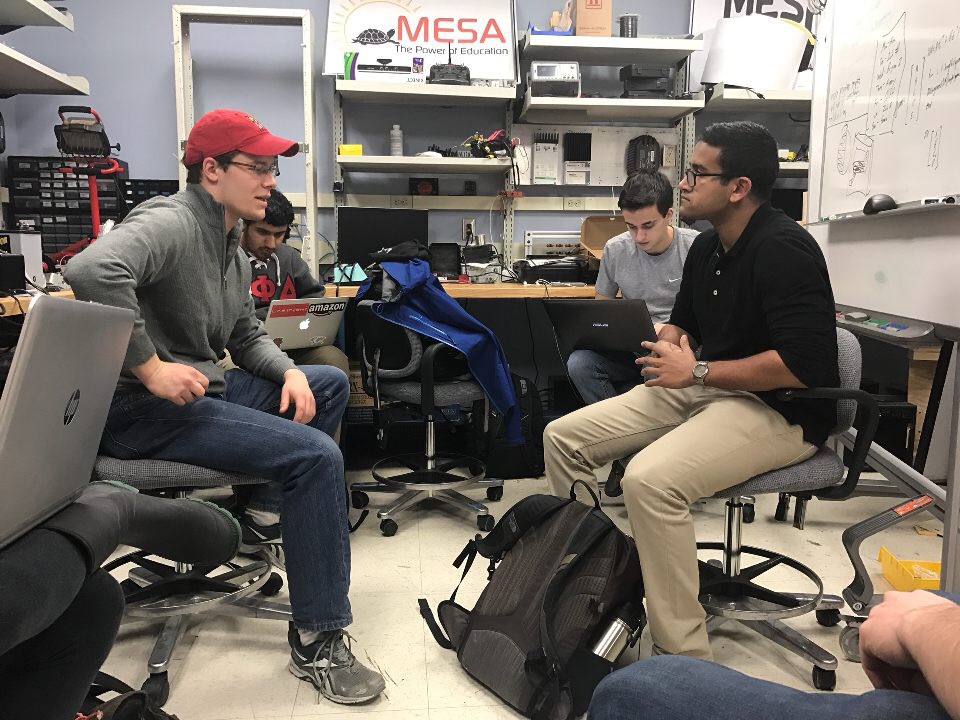A group of University of Maryland students in the Gemstone Honors Program is developing a prototype that has the potential to expand the scope of hybrid vehicle technology.
Team DRIVE, a research team made up of 12 juniors that formed in spring 2015, is working on developing a modified alternator prototype that would allow a vehicle’s driveshaft — a long metal shaft underneath the car that connects axles — to harness more electrical power for a car’s battery.
Currently, regenerative braking systems take kinetic energy produced by braking and convert it into electrical energy, which can be used to charge cars’ batteries. Implementing this technology into the driveshafts, rather than in cars’ brakes where they are currently, would improve the energy efficiency of driveshafts found in rear or all-wheel drive cars, said Zach Spawn, the team’s hardware sub-team leader and a junior chemical engineering major.
The modified technology would also make more cars into hybrids. A vehicle is considered a hybrid if it draws from more than one form of onboard energy to move. Hybrid cars use a combination of electricity and fossil fuels for power, so they cut down on fossil fuel usage and can be more environmentally friendly than non-hybrid vehicles.
“It’s very rare to see hybrid sports cars, hybrid trucks, hybrid Jeeps or really anything besides generic Prius or small front-wheel-drive sedans,” Spawn said. “By making rear wheel and all-wheel drive hybrids more feasible, you can expand the scope and create cars more desirable to American consumers.”
Alex Piqué, Team DRIVE’s team leader, said the idea to modify an alternator and use it to harness energy from the driveshaft of vehicles with rear or all-wheel drive originally came him in high school. While this sort of technology has been used before, it hasn’t been feasible to implement in rear-wheel drive or all-wheel drive cars, Spawn said.
“‘Why can’t we make that a hybrid?’ That’s what really drove me through Gemstone, to propose the project, and now it’s transformed into something much greater than I ever thought it could be,” said Piqué, a junior mechanical engineering major.
Improving energy efficiency with hybrids would help address a problem that some commuters have with hybrids — the “unattractive stigma, such as short range of battery, poor acceleration, and aesthetic appeal,” according to the team’s LaunchUMD page, which it has been using to fundraise.
The team decided to participate in Launch UMD, the university’s crowdfunding platform, to be able to afford developing a working prototype. It surpassed its $4,500 fundraising goal on March 8. Team DRIVE’s one-month campaign started on Feb. 17, and the team raised half of its $4,500 goal by March 1.
Each team member reached out to his or her friends, family and social media contacts in the fundraising effort, said Nikhil Hosamane, a Team DRIVE member and junior computer science major. And on the university’s Giving Day — just a week after the team crossed its halfway point — 25 donors gave to their Launch UMD page, and the team exceeded its $4,500 goal eight days before the project ended.
“We pretty much told all our friends and family to wait until March 8, so that way their donations would mean extra,” Hosamane said.
The fundraising initiative helps fund the necessary parts for a test rig, which is a device that could simulate real driving conditions without using a car and can show if their idea would generate enough energy to truly expand the scope of hybrid technology, Hosamane said.
Team DRIVE also received about $2,000 from this university’s sustainability fund in spring 2016, but it wasn’t enough to cover the costs associated with the project, Hosamane said. Each of the 12 Gemstone projects for juniors receives $600 a year from this university, Piqué said, adding that Team DRIVE was able to use the lab space of their mentor Bryan Quinn, a technical operations director within the engineering school. Using the space was the team’s “biggest resource,” he said.
However, the test rig requires some parts, such as sensors, that they weren’t able to borrow from this university, Piqué noted.
“We really had our eye on a very expensive sensor,” he said, “but no professor was willing to let us borrow one, so we had to buy our own, and it’s around a $5,000 sensor.”
The team is now able to afford the parts necessary for their test rig with the money from Launch UMD and the other funds the university has given the team, Spawn said.
Although Team DRIVE has already exceeded its initial goal, the group’s work isn’t done yet. Spawn said while the team isn’t creating a commercial product, they are focused on proving their idea can work. This requires the team to take many variables into account, such as the shape of the alternator used, which requires buying parts such as torque transducers — a device that measures rotational force — for the test rig as they continue to test their prototype. It also requires team members to collect more data and revise their idea.
As part of Gemstone, Team DRIVE will present its thesis in April 2018 to a team of three to five experts of its choosing, according to the Gemstone website.
“In high school it was more of just a very vague idea, but now we’re actually getting to the nitty-gritty,” Piqué said, “and getting very close to a tangible product.”



